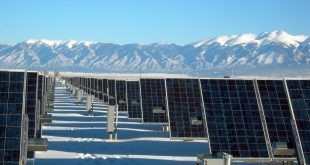It’s never a bad thing to have the leader of the free world in your corner. And President Barrack Obama made clear again last week that he’s with energy efficiency.
At a Walmart in Silicon Valley, Obama laid out his next round of green energy expansion plans. Sexy solar got much of the play in the media coverage. But staid energy efficiency was in no way ignored by the president.
“More and more companies like Walmart are realizing that wasting less energy isn’t just good for the planet, it’s good for business,” Obama said at the event. “It’s good for the bottom line.”
Obama convinced several household-name businesses to make new investments in energy efficiency – not just Walmart, but General Mills, General Motors, Whole Foods, UTC, Hilton and others. To put their commitments in perspective, Obama said that Walmart alone has agreed to reduce energy use across 850 million square feet. That’s more than half the size of San Francisco.
Keep up with the latest energy efficiency news. Follow Energy Efficiency Markets on Twitter!
The businesses were joined by schools, local governments and organizations in the latest round of commitment to the federal Better Buildings Challenge. (Full list here.)
Part of Bigger Effort
The Obama administration started the public/private program in 2011 to reduce energy use in buildings 20 percent in a decade. The initial effort drew 190 organizations and 600 manufacturers, which together are cutting their energy use 2.5 percent per year. So far, the participants have saved 36 trillion BTUs and $300 million, according to the White House.
The federal government is working on upgrading its own buildings, as well, with an additional $2 billion over three years in energy performance contracts. This adds to an initial $2 billion in the federal contracts.
Obama also announced:
- New appliance standards to reduce energy use 1.2 trillion kWh over 30 years, about as much electricity as US households use in a year. (The American Council for an Energy-Efficient Economy says the standards are the most important part of the announcement. See related article by the Appliance Standards Awareness Project.)
- Support by the Department of Energy for the latest commercial building energy code, the 2013 edition of ANSI/ASHRAE/IES Standard 90.1, to provide an additional 8.5 percent energy savings over the previous standard.
- More outdoor high performance lighting through a federal accelerator program. This includes replacing 500,000 outdoor lighting poles and developing best lighting upgrade practices for cities. The first cities to participate will be Detroit, Michigan.; greater Kansas City, Missouri; West Palm Beach, Florida.; Little Rock, Arkansas; and Huntington Beach, California
- Expansion of financing for multi-family housing through Fannie Mae and HUD/Federal Housing Administration. Building owners must commit to achieve energy and water savings equal to at least five percent of the mortgage loan amount.
The green energy plans are part of what Obama calls the power of his phone and his pen – a series of executive actions that bypass a seemingly immovable Congress. They come as the U.S. Senate appears to once again be fumbling the Shaheen-Portman bill, the one piece of significant, clean energy legislation with a glimmer of a chance of passage in recent years. The bill would strengthen building codes and boost energy efficiency incentives and research. But it appears to be mired in political wrangling over unrelated issues once again, this time the Keystone pipeline.
Timing
Obama’s new energy efficiency push also comes as the industry awaits an announcement by the Environmental Protection Agency that could bring even greater activity to energy efficiency markets. Expected on June, the rules would set carbon dioxide limits for existing power plants. ACEEE recently issued a study to show how the EPA can use energy efficiency to meet the new carbon standard.
“The energy efficiency commitments made by the president today will not only benefit the environment by lowering carbon pollution, they are good news for our pocketbooks too,” said Neal Elliot, ACEEE associate director for research, “Energy efficiency can save money in every nook and cranny of our economy-these actions will reduce energy waste in industrial plants, commercial buildings, low-income housing, restaurants and supermarkets, water treatment plants, federal buildings, and more.”
About Elisa Wood
Elisa Wood is an editor at EnergyEfficiencyMarkets.com. She has been writing about energy for more than two decades for top industry publications. Her work has been picked up by CNN, the New York Times, Reuters, the Wall Street Journal Online and the Washington Post.
 Alternative Energy HQ solar power for homes, wind energy, and bio fuel issues
Alternative Energy HQ solar power for homes, wind energy, and bio fuel issues



 Obama, Walmart team up on
Obama, Walmart team up on 







